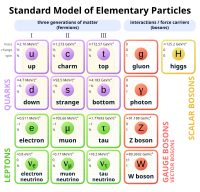
Photo from wikipedia
An iron home for Majoranas The surface of the iron-based superconductor FeTe0.55Se0.45 has been identified as a potential topological superconductor and is expected to host exotic quasiparticles called the Majorana… Click to show full abstract
An iron home for Majoranas The surface of the iron-based superconductor FeTe0.55Se0.45 has been identified as a potential topological superconductor and is expected to host exotic quasiparticles called the Majorana bound states (MBSs). Wang et al. looked for signatures of MBSs in this material by using scanning tunneling spectroscopy on the vortex cores formed by the application of a magnetic field. In addition to conventional states, they observed the characteristic zero-bias peaks associated with MBSs and were able to distinguish between the two, owing to the favorable ratios of energy scales in the system. Science, this issue p. 333 Scanning tunneling spectroscopy reveals signatures of Majorana bound states on the surface of FeTe1−xSex. The search for Majorana bound states (MBSs) has been fueled by the prospect of using their non-Abelian statistics for robust quantum computation. Two-dimensional superconducting topological materials have been predicted to host MBSs as zero-energy modes in vortex cores. By using scanning tunneling spectroscopy on the superconducting Dirac surface state of the iron-based superconductor FeTe0.55Se0.45, we observed a sharp zero-bias peak inside a vortex core that does not split when moving away from the vortex center. The evolution of the peak under varying magnetic field, temperature, and tunneling barrier is consistent with the tunneling to a nearly pure MBS, separated from nontopological bound states. This observation offers a potential platform for realizing and manipulating MBSs at a relatively high temperature.
Journal Title: Science
Year Published: 2018
Link to full text (if available)
Share on Social Media: Sign Up to like & get
recommendations!